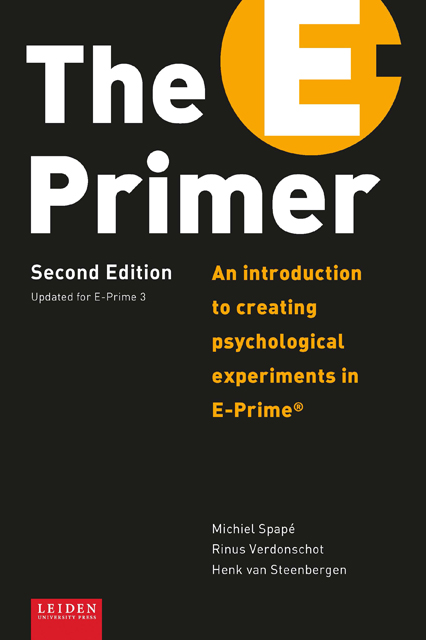Book contents
- Frontmatter
- Table of Contents
- Preface to the Second Edition
- Preface to the First Edition
- Introduction
- Chapter I E-Prime at a glance
- Chapter II List Attributes and Slides
- Chapter III Sound, movies, hardware, and nested Lists
- Chapter IV Beginning programming in E-Prime
- Chapter V Decision making in E-Basic
- Chapter VI Loops and Arrays in E-Basic
- Chapter VII Interactions between Slide objects and the Mouse
- Chapter VIII Various Input/Output devices
- References
- Appendix: Overview of available E-Objects
- About the authors
- Index
Chapter II - List Attributes and Slides
Published online by Cambridge University Press: 22 November 2022
- Frontmatter
- Table of Contents
- Preface to the Second Edition
- Preface to the First Edition
- Introduction
- Chapter I E-Prime at a glance
- Chapter II List Attributes and Slides
- Chapter III Sound, movies, hardware, and nested Lists
- Chapter IV Beginning programming in E-Prime
- Chapter V Decision making in E-Basic
- Chapter VI Loops and Arrays in E-Basic
- Chapter VII Interactions between Slide objects and the Mouse
- Chapter VIII Various Input/Output devices
- References
- Appendix: Overview of available E-Objects
- About the authors
- Index
Summary
In this chapter, you will learn
In the previous chapter, you have learned how to present texts, using TextDisplays. In this chapter, you will learn how to use ImageDisplays to present images, Slides to present combinations of images and texts, and FeedbackDisplays to present feedback about the participant's performance. Most experiments consist of multiple trials that are similar in some respects, but different in others (e.g. they display different words, numbers, images, colours or shapes). Rather than having to program each trial separately, you can use Lists that contain your trials. The List specifies which properties (attributes) of the trials are fixed and which vary from trial to trial. The List also specifies how often each trial is repeated and in which order the trials are presented to different participants (for example, sequential or random).
After completing this chapter, you will be able to program experiments such as the famous Stroop task and Simon task. What's more, you will be able to discover the hidden prejudices of your friends, by having them perform the Implicit Association Task that you will create in Tutorial III.
Experimental design in E-Prime
When it comes to programming experiments in E-Prime, it is crucial to define every part of your design to the fullest extent. This is true for psychological reasons – you will want to know beforehand how long you should display ‘Drink Coca-Cola’ in order for your prime to be subliminal; whether ‘teal’ and ‘terracotta’ are proper Stroop names, and so on. But this is obvious. However, the baffling complexity of modern computers easily hides their simple natures: they are not aware of your grand designs.
One of the best ways to approach the task of programming is to start with a good plan. For example, John Ridley Stroop may have said to himself, back in 1935: ‘Reading may be an automatic process that can interfere, or inhibit, other skills, such as naming colours’. To test it, he had to go one step further: ‘If reading and naming interfere with one another, then […] naming the colour in which a word was printed should be slower if the colour of the ink is incompatible with the word that was printed (e.g. ‘blue’ vs. ‘blue’)’.
- Type
- Chapter
- Information
- The E-PrimerAn Introduction to Creating Psychological Experiments in E-Prime, pp. 49 - 76Publisher: Amsterdam University PressPrint publication year: 2019



